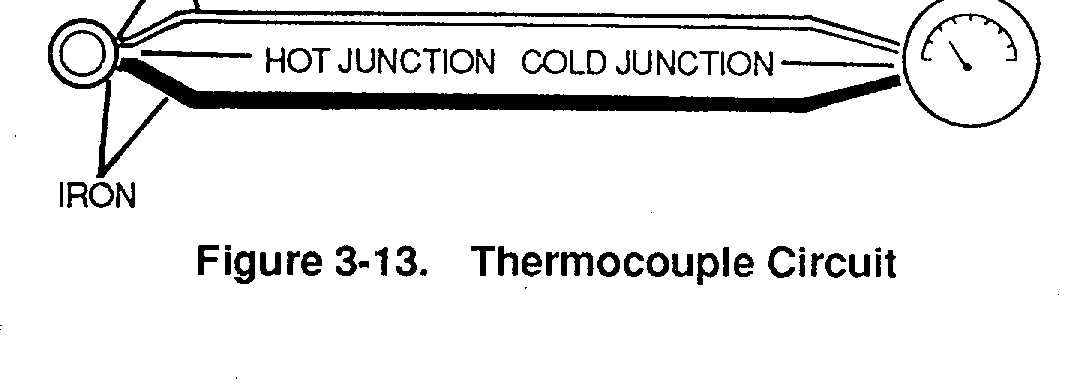TM 1-1500-204-23-4
NOTE
Lubricate only if called for by the
manufacturer's
instructions
covering the motor. Most motors
used
in
aircraft
require
no
lubrication between overhauls.
(3) Replacement criteria. Motor replacement criteria are
as follows:
·
Replace if the insulation on leads or windings is
burned, cracked, or brittle.
·
Replace when any unusual bearing or gear noises
are detected during operation.
·
Replace when commutator bars are rough, scored,
pitted, loose, high, or worn to the depth of insulating
mica between bars.
NOTE
Remove motor from aircraft when
replacing brushes.
·
Replace brushes that are cracked, broken, chipped,
unevenly worn, or worn beyond maximum wearing
depth slot.
i. Thermocouples. Thermocouples are used
throughout
the
aircraft
to
detect
and
measure
temperature changes. A thermocouple, as shown in
figure 3-13, is the junction of two dissimilar metals which
generate a small electric current according to the rate of
temperature rise. Thermocouples are commonly used
in fire warning systems and temperature indicating
instruments on Army aircraft.
18
j. Ignition Systems. Ignition systems on Army
aircraft are used for engine starting and operation.
Turbine engine ignition systems are usually operated
only for a brief period during the starting cycle, during
takeoff and landing, and during flight in bad weather
(i.e., icing conditions). Turbine engines use capacitor or
electronic ignition systems.
(1) Troubleshooting. Use applicable aircraft
maintenance manuals to troubleshoot aircraft ignition
systems. Table 3-3 is an example of a typical
troubleshooting chart for an Army aircraft ignition
system.
(2)
Replacement
criteria.
Refer
to
applicable aircraft maintenance manual for replacement
criteria.
k. Lighting Systems. Army aircraft lighting
systems include cockpit lights, instrument panel and
console lights, caution and warning light systems,
position lights, anti-collision light, searchlight, and
transmission oil level lights. Instrument panel and
cockpit lighting is provided to enhance night vision of
the flight crew.
(1) Inspection. Inspect lights for corroded
lamp socket terminals, shorted or broken wires, cracked
lens, or burned out lamp bulbs.
(2) Troubleshooting. Use applicable aircraft
maintenance manuals to troubleshoot aircraft lighting
systems. Table 3-4 is an example of a typical
troubleshooting chart for an Army aircraft lighting
system.
(3) Replacement criteria. Light assembly
may be repaired by replacing damaged or defective
component parts. If light case is damaged beyond
repair, complete unit must be replaced. Replace
missing or burned out fuses, lamps, and discolored lens.
3-19

